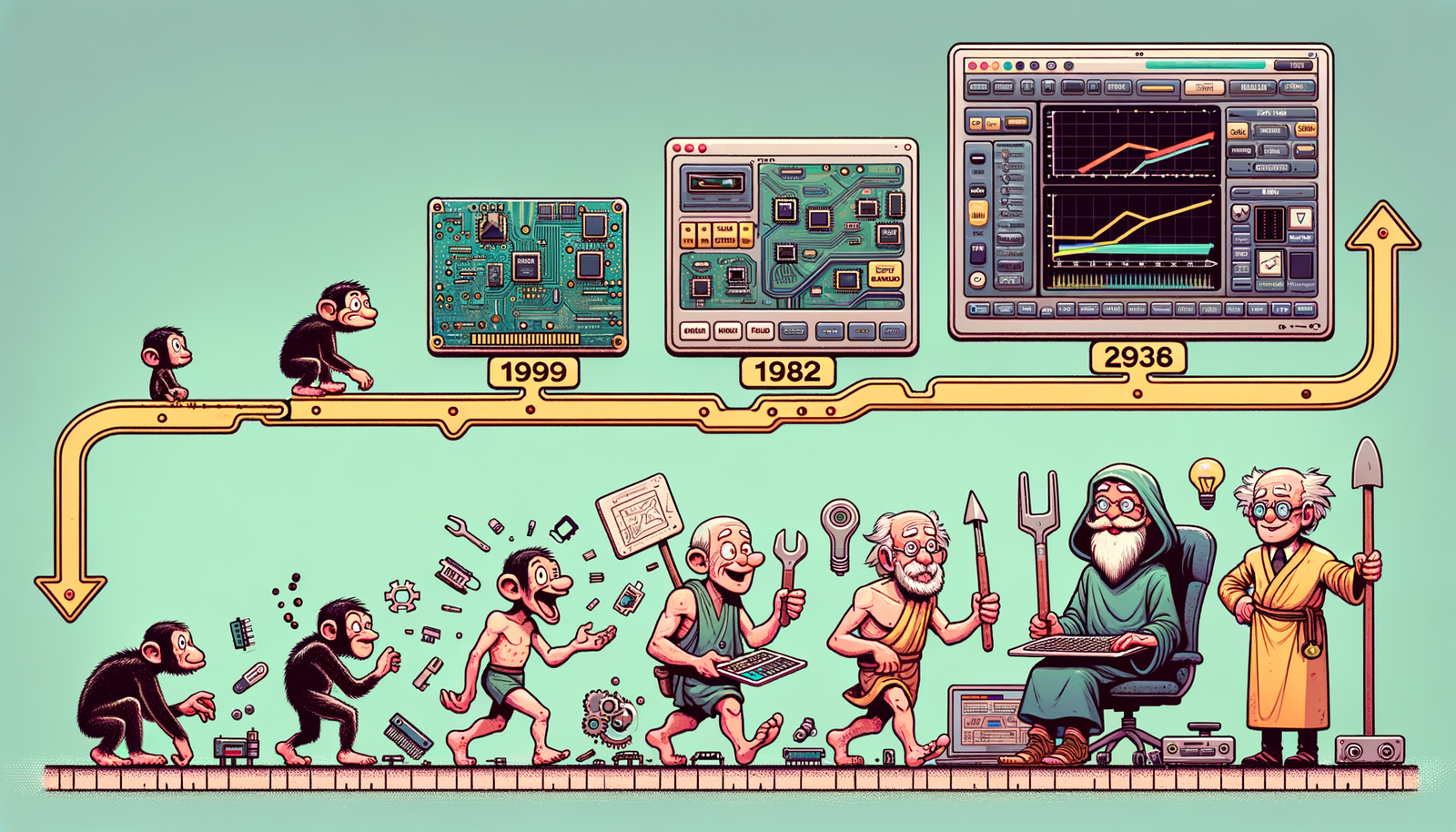Your Cart is Empty
Customer Testimonials
-
"Great customer service. The folks at Novedge were super helpful in navigating a somewhat complicated order including software upgrades and serial numbers in various stages of inactivity. They were friendly and helpful throughout the process.."
Ruben Ruckmark
"Quick & very helpful. We have been using Novedge for years and are very happy with their quick service when we need to make a purchase and excellent support resolving any issues."
Will Woodson
"Scott is the best. He reminds me about subscriptions dates, guides me in the correct direction for updates. He always responds promptly to me. He is literally the reason I continue to work with Novedge and will do so in the future."
Edward Mchugh
"Calvin Lok is “the man”. After my purchase of Sketchup 2021, he called me and provided step-by-step instructions to ease me through difficulties I was having with the setup of my new software."
Mike Borzage
Design Software History: Evolution of Altium Designer: Pioneering PCB Design Software from Protel to Modern Innovations
June 15, 2024 4 min read


Origins and Early Developments in PCB Design Software
Historical Context
The need for automated solutions in PCB design became evident during the 1980s and 1990s. As electronic devices grew more complex, manual methods of designing printed circuit boards (PCBs) were no longer efficient or feasible. Engineers and designers faced numerous challenges, such as ensuring signal integrity, managing multilayer boards, and maintaining accurate schematics.
Early attempts at automating PCB design were rudimentary and often limited in functionality. Software like ECAD (Electronic Computer-Aided Design) tools began to emerge, offering basic functionalities. However, these early solutions lacked the integration and advanced features needed for modern electronic design.
Founders and Initial Development
Nicholas Martin, an Australian engineer, recognized the growing need for more sophisticated PCB design tools. In 1985, he founded Protel, a company dedicated to developing comprehensive electronic design automation (EDA) software. Protel’s early products aimed to streamline the design process and offer greater functionality than existing tools.
Key milestones in the development of Altium Designer, originally known as Protel, include the introduction of the first DOS-based version in 1986. This was followed by Protel for Windows in the early 1990s, which took advantage of the graphical user interface capabilities of Microsoft Windows to offer a more user-friendly experience.
Technical Evolution and Key Features
Core Technologies
At the heart of Altium Designer are core technologies that have evolved significantly over the years. The software integrates schematic capture and PCB layout, two fundamental aspects of electronic design. Schematic capture allows designers to create a graphical representation of the electronic circuit, while PCB layout involves placing and routing components on the circuit board.
One of the significant advancements in Altium Designer is the use of integrated libraries. These libraries contain predefined components and models, which can be easily used in designs, enhancing efficiency and ensuring consistency across projects.
Innovative Features
Altium Designer introduced several innovative features that set it apart from other EDA tools. One of the most notable is the unified design environment. This environment integrates schematic, PCB, and FPGA design into a single software platform, enabling seamless workflow and reducing the chances of errors.
Another groundbreaking feature is the real-time 3D PCB visualization. This feature allows designers to view and manipulate the PCB in a three-dimensional space, significantly improving design accuracy and helping to identify potential issues early in the design process.
Enhanced Collaboration
Collaboration is crucial in modern PCB design, and Altium Designer has addressed this need by introducing cloud-based collaboration tools. These tools allow teams to work together in real-time, regardless of their physical location. Designers can share projects, track changes, and manage versions more efficiently.
Altium Designer also includes robust version control and project management capabilities. These features help teams keep track of modifications, maintain a history of changes, and ensure that everyone is working on the latest version of the design.
Industry Impact and Adoption
Adoption Across Various Sectors
Altium Designer has been widely adopted across various industries, including consumer electronics, automotive, aerospace, and more. Its comprehensive feature set and user-friendly interface make it suitable for a broad range of applications.
- In the consumer electronics sector, Altium Designer is used to create complex and compact devices, ensuring high performance and reliability.
- In the automotive industry, it helps design robust and reliable electronic control units (ECUs) that meet stringent safety and performance standards.
- In aerospace, the software is used to design critical components that must function flawlessly in harsh environments.
Comparison with Competitors
Altium Designer faces competition from several other PCB design software, including Eagle, OrCAD, and KiCad. Each of these tools has its strengths and weaknesses.
- Eagle: Known for its ease of use and low cost, Eagle is popular among hobbyists and small businesses. However, it lacks some of the advanced features found in Altium Designer.
- OrCAD: A powerful tool with a long history in the industry, OrCAD offers advanced features for professional designers. However, its complexity can be a barrier for new users.
- KiCad: An open-source alternative, KiCad is free to use and has a growing community of users. While it has made significant strides in recent years, it still lags behind commercial tools in terms of features and support.
Altium Designer’s unique selling points include its unified design environment, real-time 3D visualization, and robust collaboration tools. These features make it a preferred choice for many professional designers and large organizations.
Future Directions and Emerging Trends
Advancements in Design Automation
The future of PCB design is poised to benefit from advancements in AI and machine learning. These technologies can automate various aspects of the design process, such as component placement, routing, and error detection.
Predictive design, powered by machine learning algorithms, can suggest optimal component placements and routing paths based on historical data and design rules. Automated error detection can identify potential issues before they become critical, saving time and reducing costly revisions.
Enhanced Collaboration and Cloud Computing
Cloud-based design and remote collaboration tools are becoming increasingly important in the globalized and distributed work environment. Altium Designer's Altium 365 platform is a cloud-based solution that facilitates real-time collaboration, secure data sharing, and streamlined project management.
Altium 365 enables designers to access their projects from anywhere, collaborate with team members in real-time, and ensure that everyone is working with the latest design data. This platform also integrates with other cloud-based tools, enhancing productivity and reducing the time to market.
Sustainability and Eco-Friendly Design
As environmental concerns become more pressing, there is a growing trend towards environmentally sustainable PCB design. Designers are increasingly focusing on reducing waste, using eco-friendly materials, and improving the energy efficiency of electronic devices.
Altium Designer is adapting to meet new environmental standards and regulations by integrating tools that help designers assess the environmental impact of their designs. Features such as lifecycle analysis and material selection guides assist in creating more sustainable products.
By incorporating these tools, Altium Designer supports the industry’s move towards greener and more sustainable electronic design practices.
Also in Design News

Rhino 3D Tip: Wall thickness and normal verification for 3D printing
December 22, 2025 2 min read
Read MoreSubscribe
Sign up to get the latest on sales, new releases and more …




